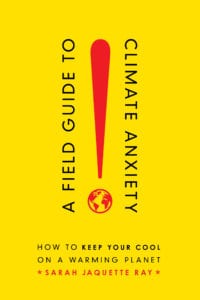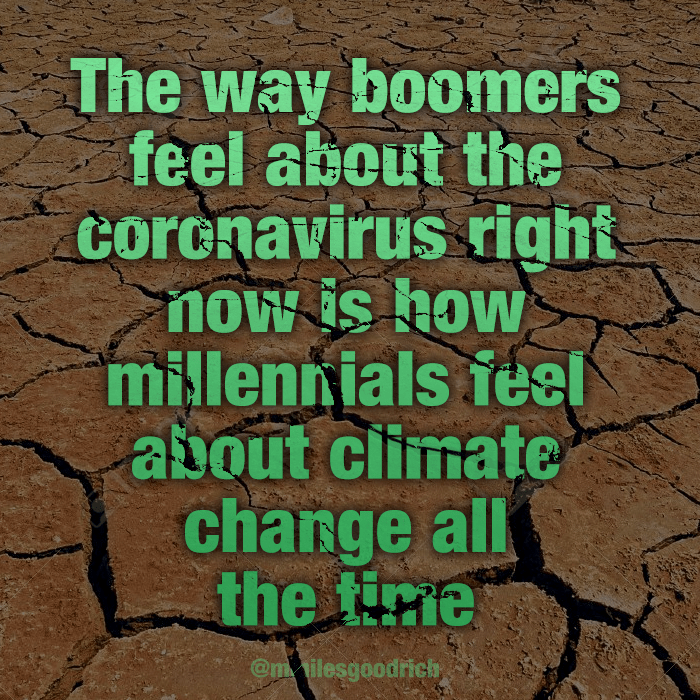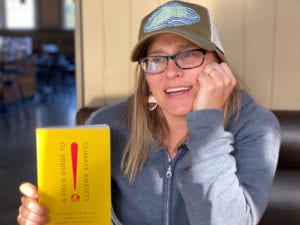by Sarah Jaquette Ray
 As a scholar in the environmental humanities, I was trained to teach the content of my research—environmental justice theory and history, discourse analysis, etc. I was also taught that teaching was the thing you had to do to pay for your time to do scholarship; it was itself not to be the subject of scholarship. A few years into my career, however, I realized that my students and their existential anguish about the content I as teaching were taking over my life. I was burning out. I couldn’t save the world, and I couldn’t save them. Feel familiar?
As a scholar in the environmental humanities, I was trained to teach the content of my research—environmental justice theory and history, discourse analysis, etc. I was also taught that teaching was the thing you had to do to pay for your time to do scholarship; it was itself not to be the subject of scholarship. A few years into my career, however, I realized that my students and their existential anguish about the content I as teaching were taking over my life. I was burning out. I couldn’t save the world, and I couldn’t save them. Feel familiar?
I will never forget sitting at an old wooden picnic table with Jennifer Ladino at an environmental humanities symposium in Utah, complaining about how I had no time for research anymore, so busy was I trying to assuage students’ despair. Jenn suggested I consider thinking about my research in a new way. Why not try researching student despair and the role it plays in the environmental classroom?* This invitation blew my mind, and that’s all I’ve been doing since.
A Field Guide to Climate Anxiety is the result of that fateful conversation. In many ways, the book is fundamentally different than any kind of scholarship I have done before. Like many of you, I felt compelled after the 2016 U.S. presidential election to make my work as an academic more public-facing and to demonstrate the indispensable value of higher education. The new urgency of our role as scholars, combined with the threats to higher education and my students’ rising anguish about the state of the world, called me to attention. I became disenchanted with scholarship for scholarship’s sake, and I was desperate to translate my training in the environmental humanities into meaningful help for my students.
I began to ask, what can the environmental humanities do to help prepare the next generation of leaders and citizens for what lies ahead, and how can they be deployed to work through the emotional turmoil flooding my email inbox, office hours, and classrooms?
Because of the urgency of the moment, I knew I needed to write a crossover book, if not a trade book, and risk the wrath of academia’s gatekeepers. I knew I had to write a book for young people, not just peers in my field. I felt compelled to help people like my students face their uncertain future; indeed, I feel we owe this to them. Not only had lessons from my teaching life completely taken over my scholarship, I now felt that a book for young people—inspired by my teaching life—was the best action I could take.
A Field Guide to Climate Anxiety brings together all of the parts of the environmental humanities that have helped me cope with and teach through climate anxiety. I have completely changed the way I teach; instead of viewing my students’ emotional responses as derailing the syllabus, I now center students’ affective journeys as the course material (see, for instance, the Curious, Compassionate Conversation project, which develops students’ abilities to communicate through difficult emotions and “be less right and more in relation,” a strategy outlined in my book).
I’m trained as an environmental humanist, not a therapist. But the environmental humanities can offer so many tools for guiding us through the existential aspects of the state of the world. And we’re foolish (or Cartesian, or however you want to view it) to think that the intellectual exercises of the field—the “head” of the proverbial triad—can be cleanly separated from heart and hand. Just as I was naïve to think that students were getting in the way of my research rather than the purpose of it, the existential aspects of climate disruption are not just a distraction in our classes—they are the whole point.
A Field Guide to Climate Anxiety is what happens when you try to make a self-help book out of environmental humanities knowledge instead of psychology. Sure, there’s some mindfulness and insights from neuroscience in there, such as Leslie Davenport’s Emotional Resiliency in an Era of Climate Change and Laura van Dernoot Lipsky’s The Age of Overwhelm. But I take my lead from all the brilliant work being done on affect by ecocritics like Nicole Seymour, Heather Houser, Alexa Weik von Mossner, Janet Fiskio, and Jennifer Ladino, and I bring it together with climate communication work by folks like Per Espen Stoknes and Anthony Leiserowitz, risk psychologists like Paul Slovic and his work with Scott Slovic (Numbers and Nerves), indigenous and critical race theorists’ views of climate change and activism (for example, Kyle Powys Whyte, Priscilla Solis Ybarra, and Julie Sze), environmental sociologists’ analyses of climate change in society (like Kari Marie Norgaard’s books), and social movement theory and practice (such as adrienne maree brown’s Emergent Strategy and Rebecca Solnit’s many analyses of how social change works), just to name a few. Educators in environmental fields are also starting to take these issues seriously (like Elin Kelsey, the editors of Contemplative Approaches to Sustainability in Higher Education, Jennifer Atkinson, Krista Hiser, Greta Gaard, Paul Wapner, and many others).
A Field Guide packages these ideas in an “existential toolkit” for the climate generation, and for anybody else who experiences climate anxiety. It offers strategies to maintain intellectual and emotional resolve for the long haul of climate advocacy. Each chapter draws on different strains in the environmental humanities to articulate a new way of looking at our experiences with climate anxiety. What I argue is that there are no easy solutions to the problems we are facing. Addressing climate change, like addressing COVID-19, will take a lot of work by a lot of people all over the planet. The fight against the climate crisis is not a sprint, it’s a marathon. For this reason, we will need to protect our internal, psychic resources as much as we will need to protect the planet’s biocultural resources. We will need to learn how to build resilience of our interiority as much as we engineer resilient communities and infrastructures.
In each of the book’s chapters, I lay out a strategy to help readers maintain their stamina to keep engaged in this work. Of course, we need to work on structural changes to create a world we can all thrive in—we need to shape political will, move public sentiment, and shift to a fossil-fuel-free economy (by engaging in such organizing as Movement Generation and the Just Transition movement). But my book focuses on what we can do to build the interior resources needed to engage in that structural work and to stay engaged.
The coronavirus is bringing these points into even sharper relief. If we didn’t think so before, we now see that denial and apathy are no longer options. If climate trauma wasn’t already a fact of your daily life before coronavirus, it is now. We need to be practicing what it would feel like to not just survive, but thrive in a climate-changed world. That world is upon us. I hope my book helps us rise to this occasion.

This meme illustrates how risk perception differs across communities and reframes coronavirus as climate change. Although my students are struggling in this time, they grasp that the crisis of coronavirus is what they’ve been anticipating for some time. The structural upheaval is traumatic, but they have been preparing for climate change to express itself in precisely this way. If my students are any indication, the climate generation has known crisis was coming and were not in the same denial that made the coronavirus disruption so alarming for others.
A whole team of editors at UC Press helped me un-learn all the scholarly writing habits I had learned, which often make our writing feel irrelevant to people like my students. But they are the very ones who will be dealing with the unfolding long emergency and slow violence (to use Rob Nixon’s language) of climate change. I am sure the book will not appeal to some scholars for this reason—it is a different form. But I’m grateful that the privileges of tenure and academic freedom allowed me to write the book I felt is needed by the people I feel most accountable to in this moment—my students and the climate generation. I’m grateful to all the people along the way—my beloved colleagues in the ASLE community—who encouraged me to think of the environmental humanities as critically important, not just intellectually, but existentially.
In the end, the story of writing A Field Guide is a story of how I’ve worked through my own climate anxiety—through relationships, many of which I have thanks to ASLE. Perhaps, at the very least, the book will show that it is possible to direct our scholarship in the service of the things we care most about—the people who sit at picnic tables with us, the students who inspire and teach us, and the relationships that sustain us in times of crisis, and joy.
*Jenn Ladino and Kyle Bladow helped me get started by encouraging me to publish “Coming of Age at the End of the World: The Affective Arc of Environmental Studies Curricula” in their edited collection, Affective Ecocriticism: Emotion, Embodiment, Environment (2018).
 Sarah Jaquette Ray is author of A Field Guide to Climate Anxiety: How to Keep Your Cool on a Warming Planet (UC Press), which comes out on Earth Day. She is hosting a virtual, free webinar book launch of the book on April 22 at 9:30am PST. Register here by April 20.
Sarah Jaquette Ray is author of A Field Guide to Climate Anxiety: How to Keep Your Cool on a Warming Planet (UC Press), which comes out on Earth Day. She is hosting a virtual, free webinar book launch of the book on April 22 at 9:30am PST. Register here by April 20.
Sarah is associate professor of Environmental Studies at Humboldt State University, where she also leads the Environmental Studies BA program. Prior to that, she led the Geography and Environmental Studies BA program at University of Alaska Southeast, where she was an assistant professor of English. Sarah received her PhD in Environmental Sciences, Studies, and Policy from the University of Oregon, where she was introduced to ASLE by participating in the planning committee for the conference in Eugene. She would later serve ASLE as graduate liaison, on the executive council, and as vice president. She is also author of The Ecological Other: Environmental Exclusion in American Culture (Arizona, 2013) and three collections edited with ASLE colleagues: Latinx Environmentalisms: Place, Justice, and the Decolonial (Temple, 2019, with Sarah D. Wald, David Vazquez, and Priscilla Solis Ybarra), Critical Norths: Space, Nature, Theory (U of Alaska P, 2017, with Kevin Maier), and Disability Studies & the Environmental Humanities (U of Nebraska P, 2017, with Jay Sibara).
